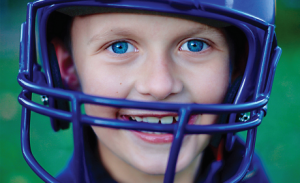It was a normal day. My older brother was pumped up, being the spirited, upbeat personality on the team. Football had been his life from elementary through high school.
This particular game, I remember him sprinting down the field toward the touchdown. With the blink of an eye, he was down. Everyone stopped, and I remember the coaches running toward him, carefully removing his helmet. My brother experienced his first of many concussions.
Before we knew it, ambulances were rushing onto the field, and he was off to the hospital. This was a scary moment for all of us, but luckily it was mild and they sent him home.
This chilling moment stuck with me. I feared signing my now 8 year old up for football. Am I putting him at risk? According to Alissa Conde, M.D. with the Sports Medicine Division at Cincinnati Children’s Hospital and Medical Center, there are risks, but that comes with any sport.
Although there are no true tried concussion preventions, you can still take preventive measures with your active sports kid.
“There are some precautions to ensure safe sport including making sure that the rules for safe play are being enforced [no illegal contacts or purposeful head to head contact while wearing a helmet to injure another athlete],” Conde says. “I also recommend that parents and coaches talk about concussion reporting with their athletes and how important it is to let them know that they have been injured.”
Football is the highest risk sport for concussions, but there are many sports that don’t fall that far behind, according to Conde. A recent study conducted by the NCAA, found that football had the highest annual number of concussions, followed by women’s soccer, women’s basketball, men’s basketball and then wrestling. In the grand scheme, a majority of kids who play football do not walk away with a concussion.
However, if your kid has experienced a concussion before, they are more likely to get another one.
“Several characteristics that increase this risk include age of the athlete [12-15 years old, higher risk] and those who had a longer course of recovery with higher symptom loads with the first diagnosis,” says Conde. “They are approximately two times more likely to get a repeat injury.”
What is a Concussion?
There’s really no great way to grade a concussion, according to Scott J. Albright, M.D., a board-certified sports medicine physician at Premier Orthopedics. They are graded on how long the symptoms last, and there is no testing, blood work or imaging to measure severity.
“A concussion is an injury in the brain that results in a temporary alteration and normal brain function,” says Albright, “so it just means that the brain had trauma to it, and it just disrupted the normal, everyday functioning which leads to the symptoms of a concussion.”
Normal symptoms tend to resolve in 10 to 14 days with some rest and by limiting physical and thinking activities, says Albright. This also depends on your kids’ age — younger kids tend to need more time for recovery compared to older.
From there, protocol is to follow a “return-to-learn” in order to avoid worsening symptoms; physical activity is a graduated “return-to-play” by specific sport.
If the concussion prolongs further, then symptoms may be more severe, and your doctor will recommend the athlete see a concussion specialist, according to Albright. In very rare cases, medication and advanced therapy will be necessary.
Practice Prevention
If your child hits his head in any instance — whether sports or play-related, take these steps to monitor your child.
• Remove them from play and consult a doctor – Rest is number one! This means no active play, a good night’s rest and restful activities during the day, and of course, call your doctor.
• Assess for red flags – Watch for signs such as the inability to wake up, slurred speech, increasing confusion, repeated vomiting, inability to walk or coordinate movement, or loss of consciousness. “These indicate emergent evaluation by a medical provider,” says Conde. Headaches, some dizziness, fogginess and nausea are all normal following an injury concerning concussion and can be managed at home with “rest to start”; and athletes can be seen by a medical provider in the coming days.
• “When in doubt, sit them out!” – Follow this motto if you are at all unsure that your active child may not be ready to play.
• Do Your Research – Stay educated on signs and symptoms of concussions, and do not ignore any complaints of symptoms from your kid. Seek medical attention if you have any questions at all regarding whether your child has a concussion or should be playing their sport after a head injury.





